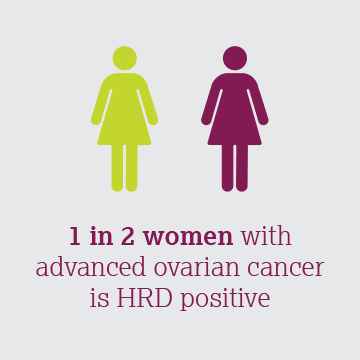Article
Precision medicine in advanced ovarian cancer: Incorporating homologous recombination deficiency (HRD) genomic instability testing to transform care
Sponsored Content by AstraZeneca
Warner K. Huh, MD

In 2021, approximately 21,000 women in the US will be diagnosed with ovarian cancer, and nearly 14,000 will die from the disease.1 The majority of women are diagnosed at the advanced stages of the disease, and about 70 percent will relapse within three years after receiving primary surgery and first-line platinum-based chemotherapy.2,3,4
However, change is on the horizon with the advent of precision medicine in advanced ovarian cancer. This shift started with the introduction of germline testing for inherited BRCA mutations, but new advances in comprehensive biomarker testing – including testing for homologous recombination deficiency (HRD) genomic instability – are continuing to usher in this change.5
“The treatment landscape for advanced ovarian cancer has evolved from where it was ten years ago, when at that stage it was very much a standard approach of surgery, chemotherapy, and then watch and wait – to one where patients receive individualized care based on the unique features of their cancer,” said Warner Huh, MD, FACOG, FACS, chair of the Department of Obstetrics and Gynecology at the University of Alabama at Birmingham School of Medicine. “I don’t think we have ever seen so many options to help improve clinical outcomes in the modern management of ovarian cancer.”
Identifying the Right Patients for Personalized Medicine
The introduction of PARP inhibitors for the treatment of certain women with advanced ovarian cancer is one recent example of how personalized medicine is transforming the way the disease is treated.6 Research has demonstrated that HRD is associated with an increased sensitivity to PARP inhibition. Women with HRD-positive disease account for approximately 50 percent of the advanced ovarian cancer population.7,8
HRD is the functional impairment in a key DNA damage repair pathway that hinders a cell from fixing damaged DNA.9 Due to the increased sensitivity of HRD-positive tumors to PARP inhibition, PARP inhibitor-based regimens in tumors with HRD may drive tumor cell death.10 Given the relationship between HRD-positivity and PARP inhibitor regimens, HRD genomic instability testing is an important component of advanced ovarian cancer management.11
“Advanced ovarian cancer is a tough disease. When I see a patient is HRD-positive, I make sure they understand the results. I use it as an opportunity to share what it may mean for their care,” said Dr. Huh. “This conversation can also serve as a way to discuss the full treatment path ahead and set expectations for what’s to come during different phases of their treatment journey.”
HRD-positive tumors are identified via detection of certain mutations that signal the presence of HRD, such as BRCA1/2 mutations and markers of genomic instability (including loss of heterozygosity (LOH)).12
“In today’s treatment landscape, where cancer therapy is becoming increasingly personalized and biomarker-based, every woman diagnosed with advanced ovarian cancer should receive HRD genomic instability testing. Knowing that roughly half of our patients are HRD-positive, this testing can identify important information about their tumor which may better inform their treatment plan than testing for a BRCA mutation alone – which is present in approximately just 25% of women with the disease,” said Dr. Huh.8,12,13
“This puts into perspective the importance of HRD genomic instability testing. Without this test, we do not have all the information for informed decision-making with regards to devising a comprehensive treatment plan for our patients. Having all the information is even more crucial as we aim to offer our patients hope."
However, given the various testing options across tumor types and the overall ongoing evolution in tumor-specific biomarker and genetic testing, gaps in knowledge about HRD genomic instability are complicating the testing landscape and hindering oncologists from consistently conducting the right tests immediately following diagnosis.

Elevating the Standard of Care by Addressing Gaps in Knowledge
According to a recent US survey of 230 oncologists conducted by Kantar and sponsored by AstraZeneca, many clinicians often underestimate the prevalence of HRD in ovarian cancer and the role it plays in treating cancer. The survey, which sought to better understand HRD genomic instability testing habits, barriers to testing and current knowledge gaps, showed that two-thirds of oncologists surveyed thought that fewer than 40 percent of women with advanced ovarian cancer are HRD-positive – though the prevalence is much higher at 50 percent.13,14,16
The survey also revealed a common misunderstanding about the role of disease markers in ovarian cancer in this rapidly evolving space. Although three-quarters of respondents said that they were “extremely” or “very” familiar with HRD testing, 73% among that group incorrectly said that homologous recombination repair (HRR) gene panels found in next-generation sequencing (NGS) tests help identify markers of genomic instability, when in fact, HRD genomic instability and BRCA are the only actionable biomarkers for use of PARP inhibition-based regimens known today.12,14
“HRR and HRD are both important features in DNA damage response, but the two terms are often confused. HRR is not a marker of genomic instability and is not a predictive biomarker for who may respond to PARP inhibition in advanced ovarian cancer – so an HRRm gene panel should not be used in place of an HRD test to help inform treatment decisions,” said Dr. Huh.
Integrating HRD Genomic Instability Testing into the Full Treatment Plan
“We’re only at the tip of the iceberg in expanding the clinical utility of precision medicine. We can go even further to improve the treatment of advanced ovarian cancer,” – Dr. Warner Huh
Now, with a deeper understanding of the underlying biology of advanced ovarian cancer, oncologists have the tools to match the right treatment with the right patient.
Available tests for identifying HRD genomic instability in advanced ovarian cancer include: MyChoice® CDx from Myriad Genetics; FoundationOne® CDx from Foundation Medicine; Caris Molecular Intelligence® Comprehensive Genomic Profiling Plus (CGP+) from Caris Life Sciences; and Tempus xT from Tempus. Not all of these tests are FDA-approved companion diagnostics for PARP inhibitor therapies. However, 21% of the oncologists in the survey who say they have ordered HRD testing did not select any of these HRD testing partners when presented with a list of 12 choices.15,16,17,18
“These gaps demonstrate that there is still more work to be done to ensure patients receive the right test as soon as possible following diagnosis to inform treatment decisions. One way to approach this is by adding a literal checklist to your clinical routine. In my practice, this checklist includes HRD genomic instability testing and germline testing at the earliest opportunity to ensure we are providing the optimal information to our patients. Simple things can make a big difference and the earlier you conduct HRD genomic instability testing, the better.”
“We’re only at the tip of the iceberg in expanding the clinical utility of precision medicine. We can go even further to improve the treatment of advanced ovarian cancer,” said Dr. Huh. “To sustain progress, the medical community needs to move beyond BRCA testing alone and conduct HRD genomic instability testing at the first opportunity. Without this information, physicians may not be able to optimize treatment decisions based on the patient’s individual’s type of disease.”
“As we aim to work towards a cure for this devastating disease, we can enhance our care discussions by educating about comprehensive biomarker testing and ensuring that we order the right tests at the right time.”
Learn more about incorporating HRD testing into clinical practice.
Dr. Warner Huh was compensated for his time associated with this article.
References:
- American Cancer Society. Key Statistics for Ovarian Cancer. https://www.cancer.org/cancer/ovarian-cancer/about/key-statistics.html. Revised January 12, 2021. Accessed September 28, 2021.
- Doubeni CA, Doubeni AR, Myers AE. Diagnosis and Management of Ovarian Cancer. Am Fam Physician. 2016;93(11):937-944.
- Ozols RF, Bundy BN, Greer BE, et al; Gynecologic Oncology Group. Phase III trial of carboplatin and paclitaxel compared with cisplatin and paclitaxel in patients with optimally resected stage III ovarian cancer: a Gynecologic Oncology Group study. J Clin Oncol. 2003;21(17):3194-3200.
- Perren TJ, Swart AM, Pfisterer J, et al. A phase 3 trial of bevacizumab in ovarian cancer. N Engl J Med. 2011;365(26):2484-2496.
- Frey MK, Pothuri B. Homologous recombination deficiency (HRD) testing in ovarian cancer clinical practice: a review of the literature. Gynecol Oncol Res Pract. 2017;4:4.
- Konstantinopoulos PA, Lheureux S, Moore KN. PARP Inhibitors for Ovarian Cancer: Current Indications, Future Combinations, and Novel Assets in Development to Target DNA Damage Repair. Am Soc Clin Oncol Educ Book. 2020;40:1-16.
- Yi T, Feng Y, Sundaram R, et al. Antitumor efficacy of PARP inhibitors in homologous recombination deficient carcinomas. Int J Cancer. 2019;145(5):1209-1220.
- Cancer Genome Atlas Research Network. Integrated genomic analyses of ovarian carcinoma. Nature. 2011;474(7353):609-615.
- O'Connor MJ. Targeting the DNA Damage Response in Cancer. Mol Cell. 2015;60(4):547-560.
- Rose M, Burgess JT, O'Byrne K, et al. PARP Inhibitors: Clinical Relevance, Mechanisms of Action and Tumor Resistance. Front Cell Dev Biol. 2020;8:564601.
- Pennington KP, Walsh T, Harrell MI, et al. Germline and somatic mutations in homologous recombination genes predict platinum response and survival in ovarian, fallopian tube, and peritoneal carcinomas. Clin Cancer Res. 2014;20(3):764-775.
- Miller RE, Leary A, Scott CL, et al. ESMO recommendations on predictive biomarker testing for homologous recombination deficiency and PARP inhibitor benefit in ovarian cancer. Ann Oncol. 2020;31(12):1606-1622.
- Konstantinopoulos PA, Ceccaldi R, Shapiro GI, et al. Homologous Recombination Deficiency: Exploiting the Fundamental Vulnerability of Ovarian Cancer. Cancer Discov. 2015;5(11):1137-1154.
- Data on File. REF-59657. AZPLP.
- Myriad Genetics, Inc. Technical specifications. https://myriad-web.s3.amazonaws.com/myChoiceCDx/downloads/myChoiceCDxTech.pdf. Published August 23, 2021. Accessed September 28, 2021.
- FoundationOne® CDx. Technical Information. https://assets.ctfassets.net/w98cd481qyp0/41rJj28gFwtxCwHQxopaEb/500e5840335a91287f13e6d24c528034/FoundationOne_CDx_Label_Technical_Info.pdf. Accessed September 28, 2021.
- Caris Life Sciences. Caris Life Sciences' Molecular Intelligence Platform Measures Prevalence of Oncogenic Homologous Recombination Pathway Mutations Across 53,000 Tumors. https://www.carislifesciences.com/about/news-and-media/caris-life-sciences-molecular-intelligence-platform-measures-prevalence-oncogenic-homologous-recombination-pathway-mutations-across-53000-tumors/. Published 2017. Accessed September 28, 2021.
- Tempus. The Tempus HRD Test. https://www.tempus.com/wp-content/uploads/2020/05/Tempus-Tech-Spotlight-The-Tempus-HRD-Test.pdf. Published 2020. Accessed September 28, 2021.